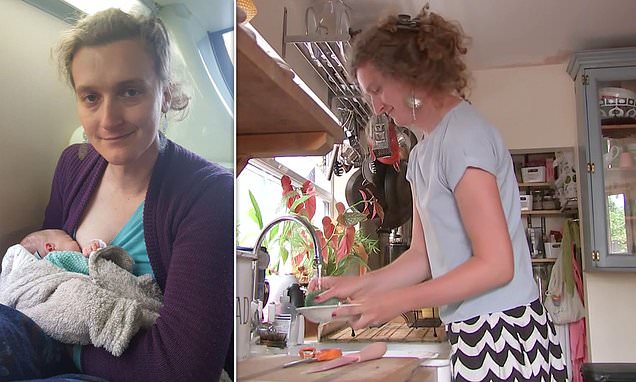Can a person who was born male REALLY breastfeed a baby? The answer will shock you
The scene is a familiar one: three o’clock in the morning, the baby wakes for yet another feed. Exhausted mum drags herself out of bed and soothes her crying infant at the breast.
She looks enviously at her sleeping male partner as he snores contentedly, and feels a surge of irritation. How unfair it is that he can’t share this particular load, she thinks.
And yet the latest row in the world of transgender politics might make her think twice.
For a picture posted on social media this week by trans woman Mika Minio-Paluello, who was born male but now identifies as a woman, appears to show her breastfeeding her baby on a bus, with the accompanying message ‘Trans women can breastfeed’.
Have women been doing this wrong all along, the frazzled mum might well wonder.

For a picture posted on social media this week by trans woman Mika Minio-Paluello, who was born male but now identifies as a woman, appears to show her breastfeeding her baby on a bus, with the accompanying message ‘Trans women can breastfeed’

Last month, she appeared as a case study in a piece on ITV News at Ten about the cost-of-living crisis
Minio-Paluello’s post was in response to an earlier controversy. Last month, she appeared as a case study in a piece on ITV News at Ten about the cost-of-living crisis, in which she did the dishes and loaded the washing machine, while claiming that rising water prices are ‘tough if you are a mum like me’.
Feminists were outraged. MP Rosie Duffield, for example, objected to the word ‘mum’ being appropriated by someone born male. (Minio-Paluello retorted that ‘trans women can be mothers — it’s not up to an MP or anyone else . . . to enforce what a child calls their parent’.)
It was as though ITV had chosen someone to ‘role-play’ the genuine struggles of underpaid mothers, said another feminist.
READ MORE: A man having a baby suck his nipple is not breastfeeding’: Gender-critical campaigners slam trans woman activist for using a child as an ‘identity prop’ after she posted image of her breastfeeding on a bus
Others pointed out the sexism in the idea that wearing a skirt and being busy in the kitchen was what made someone a mother rather than the act of gestating and giving birth to a baby.
Plenty of people on social media highlighted the double standards of trans women using the word ‘mum’ while at the same time official NHS maternity literature reduces biological women to ‘birthing people’ or ‘cervix-havers’.
At which point Minio-Paluello posted the breastfeeding picture, as if to prove that those born male could not only dress ‘like a mum’, but perform the biological functions of one, too. Cue predictably huge, ongoing outcry.
So what’s the truth? Can a biological male really breastfeed a baby by producing milk from their nipples?
The complex answer is yes and no.
By using a regimen known as the Newman-Goldfarb protocol, originally developed in 2000 for adoptive mothers, the body can be tricked into lactating even if it’s male.
It works by mimicking the hormonal changes that take place naturally in the body of a woman who has just given birth, and involves several weeks of regularly using a pump to stimulate the breast, taking a combination of contraceptive hormones and the anti-nausea drug domperidone, which increases levels of the milk-producing hormone prolactin.
But if that sounds simple, it really isn’t. For a start, domperidone is banned in the U.S. over concerns it causes heart problems.
The NHS still offers it sometimes to breastfeeding women who are struggling with low milk supply, as long as neither mother nor baby has any heart issues, and with clear instructions to report any changes in the baby’s behaviour.
It should be used, says official guidance, only ‘for a short time’. (Minio-Paluello says she breastfed her child for ‘a few weeks’.)
What’s more, it’s not at all clear what else is in a trans woman’s ‘milk’. Since trans women are likely to be taking other prescription drugs as part of their transition, such as anti-androgens to lower their production of testosterone, and oestrogen and progesterone to help them create a less ‘masculine’ appearance, critics say the milk is potentially unsafe for a newborn, or at the very least should be rigorously tested.
Feminists mutter darkly about yet more double standards from the medical establishment — women, after all, are told to avoid aspirin while breastfeeding and to abstain even from the odd glass of wine because no one knows how much gets through in the milk.
Until very recently, of course, the idea of a small baby being nursed by a biological male would have been regarded as quite bizarre, and the truth is there is very little research into male ‘milk’.
Numbers are hard to come by — there are a dozen recorded cases of induced lactation in those born male, with numbers thought to be rising over the past two years.
In 2020, 34 per cent of health professionals attending an event on transgender health said they had met trans women who had expressed an interest in inducing lactation, and 91 per cent of them thought there was a need for specialised medical protocols for trans women who want to breastfeed.

In 2020, 34 per cent of health professionals attending an event on transgender health said they had met trans women who had expressed an interest in inducing lactation, and 91 per cent of them thought there was a need for specialised medical protocols for trans women who want to breastfeed (stock image)
One study said the composition of the fluid produced by male breasts after engaging in the Newman-Goldfarb protocol was roughly similar to that of female milk, but it’s thought unlikely that males are able to produce enough to exclusively feed a baby. (There has been one documented case of a trans woman feeding a baby exclusively from birth, but at six weeks they had to supplement with formula.)
For now, say feminists — and, of course, it feels absurd to write this — a small baby being nursed by a male is essentially participating in an experiment.
‘We simply don’t have the studies,’ Professor Jenny Gamble, who is a midwifery expert at Coventry University, told me.
‘Ultimately, we need to shift the focus of the question and ask why this practice is happening in the first place. What are the benefits to the baby, or the birth mother?’
Like so much of the debate around trans issues, however, it’s harder than it sounds to raise these questions.
I have been a breastfeeding, birthing and motherhood specialist for more than a decade, and have three books and a podcast on the subject to my name. This is my patch — and I know the professionals who work in it well.
Yet because people who raise doubts about trans women inducing lactation are immediately accused of transphobia, it is almost impossible to find experts willing to comment on the issue.
‘I cannot have my name attached to this — it could cost me my registration,’ several have told me.
Indeed, many breastfeeding professionals have already been threatened with disciplinary action or ejected from social media groups for raising concerns.
READ MORE: How trans women use a powerful mix of hormones, drugs and pumps to ‘breastfeed’ babies – but how safe is it really? And does it actually nourish a child?
Large numbers belong to secret WhatsApp or Facebook groups, but cannot publicly state their views. ‘If I get kicked out of my organisation, ultimately it is mums and their babies who will suffer,’ one told me. ‘So, for now, I have to stay silent.’
Some scientists seem positive. A paper in The Journal of Human Lactation earlier this year stated that: ‘For transgender women . . . on oestrogen-based, gender-affirming hormone therapy, the ability to nourish their infants through production of their own milk may be a profoundly gender-affirming experience.’
What many experts say in private, however, seems utterly uncontroversial to most of us — that female breast milk is a miraculous biological substance with properties the male equivalent simply can’t replicate.
Breast milk, after all, is a ‘live’ substance, which adapts to a baby’s needs with remarkable precision.
Many of us will know about colostrum — the ‘liquid gold’ that is produced in the earliest days of breastfeeding. It’s packed with antibodies, antioxidants, vitamins and nutrients in much higher quantities than in breast milk.
Colostrum production has never been observed in males.
Around three days after birth, a woman’s milk then ‘comes in’ but changes constantly for about two weeks, until it becomes established as mature breast milk.
After that, it continues to change, often very subtly, according to a baby’s needs.
If the baby sucks for a short time, they get a more watery, thirst-quenching milk, known as foremilk. If they keep sucking, they will get hindmilk, which is richer and higher in calories.
Breast milk also changes as the baby grows, perfectly tailoring itself to their age and development, with premature babies’ milk being specifically higher in fat, calories and protein, while milk for older babies is richer in immunity-boosting qualities.
In fact, we are constantly discovering mind-blowing ways in which this remarkable liquid serves a newborn.
When a mother kisses her baby, for example, she samples pathogens on their face which then travel to her lymphatic system and cause antibodies to be created, which the baby receives through her milk.
It’s also thought that there is a complex feedback loop between the baby’s saliva and the mother’s nipple, which ‘informs’ the breast about the baby’s health needs, again causing antibodies to increase if they have a virus, for example.
Milk produced by females is a real-time immune system factory. There is no evidence that induced lactation in males can do any of these things.
It’s not always easy for new mothers to breastfeed, of course. Yet help from the NHS and independent organisations is already stretched thin, and many professionals tell me they are baffled and infuriated by resources being spent on promoting the idea of male people trying to lactate when so many women are struggling to find adequate support. The pro-breastfeeding group La Leche League, for example, devotes lengthy space on its website to the issue.
‘About 85 per cent of mothers start breastfeeding in the UK, but that drops by about 50 per cent in the first six weeks, with as many as nine out of ten saying they didn’t want to stop but couldn’t find the help,’ one woman, who did not want to be named but who is involved in breastfeeding education, told me.
‘All of our focus should be on working to change those numbers — it is farcical that we are even talking about lactation in men.’
Much of the discussion around nursing by trans women has been focused on how it’s possible, what the liquid is exactly, and whether or not it is safe.
These are all interesting questions, but they fail to address the true issue: why is it necessary?
Trans women claim that the experience of nursing is ‘gender-affirming’. In other words, it makes them feel more ‘female’. But ‘affirming’ an adult’s feelings is not the point of breastfeeding.
As much as a mum may wish at 3am that men could breastfeed, too, it seems that the male body just isn’t built to nourish and support a child in this way. It feels extraordinary to have to say it, but long-term breastfeeding really is something special that only female people can do.
It seems to me that going to great lengths to induce a small amount of milk in a male body does nothing to serve either women, or the person who, of course, should be at the centre of any breastfeeding experience — the baby.
Source: Read Full Article



